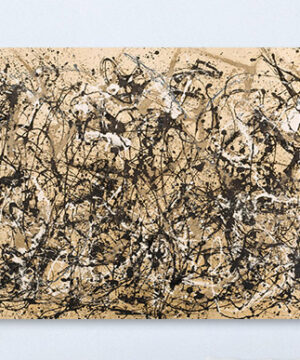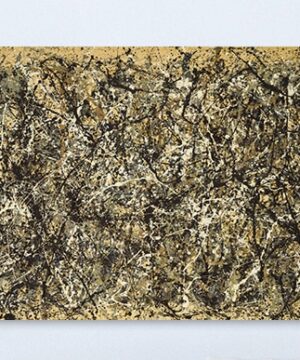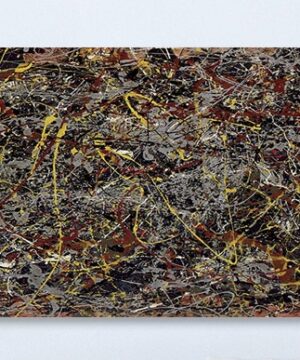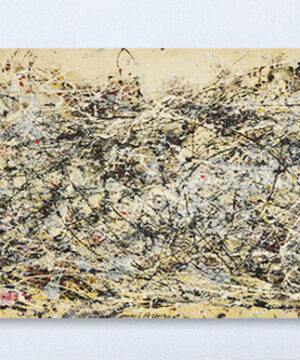Pollock
American painter Jackson Pollock (1912 – 1955) was one of the leading figures of Abstract Expressionism and the New York School. He is best known for his large action drip paintings, which he produced between 1947 and 1952, created by pouring and manipulating liquid paint atop canvases set on the floor.
Pollock was born in Cody, Wyoming and grew up in Arizona and California. In 1928 he began to study painting at the Manual Arts High School in Los Angeles. In 1930 he started studying under Thomas Hart Benton at the Art Students League in New York. At this time the murals of José Clemente Orozco and Diego Rivera had a strong impact on Pollock. He found jobs contributing to the Works Progress Administration Federal Art Project and in David Alfaro Siqueiros’s experimental workshop in New York in the mid-1930s. He was supported by Peggy Guggenheim during the 1940s who gave him a contract lasting half a decade, which permitted him to devote all his time to art. His was able to stage his first solo show at Guggenheim’s Art of This Century, New York in 1943.
Prior to 1947 Pollock’s work reflected the influence of Pablo Picasso and Surrealism. During the early 1940s he contributed paintings to several exhibitions of Surrealist and abstract art, including Natural, Insane, Surrealist Art (1943) at Art of This Century, and Abstract and Surrealist Art in America (1944), organized by Sidney Janis at the Mortimer Brandt Gallery, New York.
While prior to 1947 Pollock’s work reflected the influence of Surrealism as well as Pablo Picasso, as well as of his artist wife Lee Krasner, by the mid-1940s he began painting in an entirely abstract manner. He liberated himself from painting at the easel by putting unstretched canvas on the floor. Developing his signature “drip style” which he is most famous for today, he explored the usage of sticks and knives to splatter paint or pouring paint directly from the can onto the canvas. In line with Surrealist notions of the automatic painting and the expression of the subconscious, he created decisive foundations for the further development of Abstract Expressionism and contemporary art in general.
IN 1950, Peggy Guggenheim organized Pollock’s first European solo exhibition at the Museo Correr, in Venice, while critic Clement Greenberg organized his first retrospective at Bennington College, Vermont. Pollock further participated in numerous group exhibitions including the Venice Biennale in 1950.
Pollock struggled with mental health issues and suffered several nervous breakdowns throughout his life. He got psychiatric treatment for alcoholism seeing Jungian psychologists and was institutionalized several times. Under the influence of alcohol, he was killed in an automobile accident on August 11, 1956, in East Hampton.
Showing all 4 results
-

Autumn Rhythm (Number 30) by Jackson Pollock – Canvas Giclée Print
$119.00 – $269.00 -

One: Number 31 by Jackson Pollock – Canvas Giclée Print
$119.00 – $269.00 -

Number 5 (1948) by Jackson Pollock – Canvas Giclée Print
$119.00 – $269.00 -

Number 1A (1948) by Jackson Pollock – Canvas Giclée Print
$119.00 – $269.00
